On August 11, NHDC issued a tender for the design, engineering, procurement and construction of the 25 MW floating solar energy project. The contract also includes the full operation and maintenance of the power plant, including the 33 KV transmission line and switching station in the central state, for a period of five years.
Earlier on June 30, NHPC, the state power company, also invited bids for the design, procurement and construction of a 50 MW floating solar power project in West kallada, Kollam District, Kerala, with a deadline of September 5.
Rajneesh Sharma, Deloitte's renewable energy director, said: "in the recent tender we saw an increase in the capacity of floating solar projects, which bodes well for this segment.
Ashish Kulkarni, associate partner in business consulting at Ernst & Young, said more than 1700 megawatts of floating solar projects in India are at different stages of development, and more are under preparation.
"Floating solar has great potential to help save land," said Santosh kamath, KPMG's partner and head of energy in India. Floating solar technology is an effective alternative to the use of solar energy in limited land. With this technology, solar panels can be installed on floating platforms on water bodies such as dams, reservoirs and lakes. At present, many parts of India are facing the problems of scattered land tenure and high land cost, which has prompted policy makers and utility companies to explore the field of floating solar energy. As water resources are owned by government agencies, the government is encouraging private participation in the development and utilization of water resources in floating solar energy projects. At present, the field is still in the initial stage of development, but if developed, it will become a good alternative to the installation of solar projects. "
Floating solar technology has many advantages. He said that it can be mixed with hydropower dams and reservoirs and take advantage of existing transmission infrastructure. It helps to reduce algae growth, and can reduce evaporation to save water resources and reduce pollution losses. It is easy to clean, simple to install and deploy, and it is a new source of income.
According to a report released by Teri in February, the investment cost of India's floating solar power project is by far the lowest in the world, with developers bidding for the country's first large floating solar power plant with a capacity of 70 MW as low as INR 35 per watt. The investment cost has dropped significantly by 45% in the past two years. The main reasons for the cost reduction are the improvement of manufacturing process, the reduction of material cost, the reduction of float thickness and the active bidding of project developers to gain experience in the industry, the report said.
At the same time, some industry experts said that because India has rich experience in the development of ground-based solar power generation projects, which can help to study the water-surface projects and evaluate their feasibility and benefits. Thus, floating solar power generation in India has a very good prospect.

